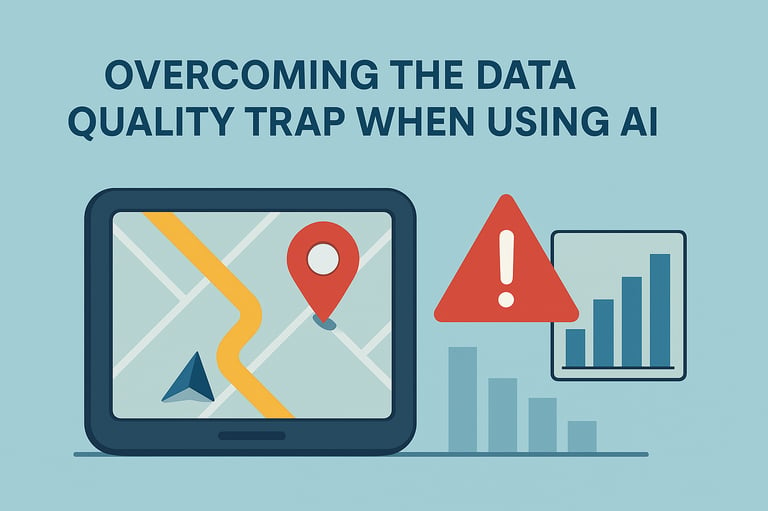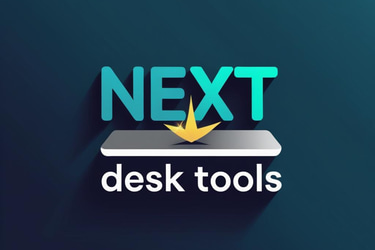Overcoming the Data Quality Trap When Using AI
Learn why AI fails without clean data — and how to fix it. Discover how outdated “maps” misguide AI, and how better daily data habits rebuild trust, accuracy, and results.
10/30/20254 min read


Last month, I sat across from Sarah, a marketing director at a mid-sized retail company, as she vented her frustration. Her team had spent six months — and a considerable chunk of their budget — implementing an AI-powered customer recommendation system. The vendor promised it would revolutionize their campaigns and boost sales by 20%.
“It recommends winter coats to customers in Florida,” she said. “It suggested dog food to someone allergic to pets — and baby products to our 70-year-old customers.”
The AI wasn’t broken. The data feeding it was.
Sarah had fallen into what I call the data quality trap — when AI runs confidently on bad information.
🧭 The Trap Nobody Sees Coming
Imagine driving somewhere new using your car’s GPS. It confidently tells you to “turn right in 200 meters,” but the road it’s referencing was rerouted years ago. You trust it because it sounds sure of itself — until you’re staring at a dead end.
That’s exactly what happened to Sarah’s AI system. It wasn’t malfunctioning; it was following directions from an outdated map.
“AI isn’t wrong — it’s just following an old map.”
Most organizations fall into this trap. Their data — the map guiding their AI — hasn’t been updated, validated, or aligned with reality. And like that GPS, AI will happily navigate you straight into a wall if its information is wrong.
💾 When Good Data Goes Bad
Data doesn’t sit still. It expires, like fruit in your fridge.
Janet, who led customer service at a telecom company, learned this the hard way. Her team built an AI chatbot trained on two years of service transcripts. It worked perfectly in testing — until launch day.
“It was like hiring someone who’d been in a coma for two years and expecting them to handle customer calls,” Janet said.
That’s the quiet danger of data decay: what was accurate once becomes misleading tomorrow. Think about your own phone contacts — how many are still current? Multiply that by thousands of customers, and you see how fast “good data” goes bad.
⚠️ The Ripple Effect of Bad Data
The damage goes beyond one failed AI project. It’s what happens afterward.
A healthcare organization I worked with tried to predict which patients might miss appointments. The model’s results were terrible — but the real loss was trust. When the IT team later proposed a different AI tool to reduce hospital readmissions, doctors refused to use it.
“Once trust is broken, even the right data won’t rebuild it overnight.”
That loss of confidence can stall real innovation for years.
🔍 Finding Your Way Out
So how do you escape the trap?
Not with expensive software — but with honesty.
After her AI debacle, Sarah gathered her team to audit 100 random customer records. They found errors in over a third — wrong addresses, outdated preferences, even one customer listed as 247 years old.
“We thought our data was 90% good,” Sarah said. “Seeing the reality changed everything.”
That small audit became their turning point. They didn’t fix everything at once — just what mattered most.
🎯 Focus on What Matters Most
Sarah’s team identified the key data that drove results: purchase history, postal codes, and preferences. They cleaned only those fields and verified customer info through a short survey.
“We went from 66% good data to 94% on what mattered,” Sarah said. “And suddenly, the AI started working like we’d hoped.”
Her insight is gold: perfection isn’t the goal — progress is.
🧰 Stop the Bleeding
Here’s a truth most teams ignore: your data is getting messier right now.
Someone just entered a name in all lowercase. A product was categorized wrong. These tiny errors pile up until your data pipeline looks like a clogged drain.
Carlos, an IT director at a logistics firm, learned that lesson fast. His team spent months fixing years of messy data — and six months later, it was messy again.
“We fixed the past but didn’t change the future,” he said. “It was like mopping up water while the pipe was still leaking.”
Their real fix came when they made data quality a daily habit. Delivery entries were validated in real-time, inventory logs formatted consistently, and addresses verified automatically. It wasn’t glamorous — but it stopped the leaks.
🤝 Make It Everyone’s Job
The companies that escape this trap stop treating data as an IT issue — they make it everyone’s responsibility.
At Sarah’s company, the marketing team saw how bad data inflated bounce rates and skewed campaign results. Once people connected those errors to their own goals and bonuses, fixing them became personal.
“We stopped talking about ‘data hygiene,’” Sarah said. “We started talking about how messy data was costing us money.”
When data becomes visible, it becomes valuable.
🚀 Start Small, Learn Fast
The biggest mistake teams make? Waiting until everything’s perfect before starting.
Marcus and his manufacturing team retried their AI project using data from just one machine — the newest, cleanest one. It worked. From there, they learned exactly what needed to change to scale across older machines.
Within a year, their predictive system cut downtime by 40%.
But they didn’t wait a year to start.
🌱 Where We Go From Here
AI is getting more powerful every day. But more power on top of bad data doesn’t make it better — it makes it wrong faster.
The companies that thrive won’t be the ones with the fanciest algorithms. They’ll be the ones that treat their data like a living system — maintained, monitored, and respected.
Sarah’s recommendation engine now drives a 23% revenue boost. Marcus’s system saves hours of downtime. Janet’s chatbot finally helps customers instead of confusing them.
None of it came from magic tech.
It came from updating the map before trusting the GPS.
“More powerful AI fed with bad data doesn’t make it smarter — it just makes it wrong faster.”
So, start with honesty. Fix what matters most. Stop the leaks. Make it everyone’s job.
Your data won’t ever be perfect — but it can be good enough to make AI actually work.
💡 Build Better AI Habits — One Day at a Time
Big changes start with small, consistent habits — and the same applies to data and AI.
Use the AI Habit Tracker to build daily awareness, stay organized, and make progress visible.
📘 Download your free AI Habit Tracker
Track what you learn, what you fix, and what you automate — one week at a time.
(Note: Written with a little AI help—and plenty of human judgment.)
